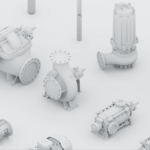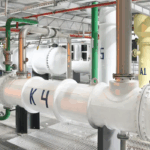Selecting a heat exchanger: key criteria
If you need a standard heat exchanger, many manufacturers offer them. However, if you have specific requirements, you can order a heat exchanger with a customised design to suit your application and operating conditions. Your choice should be based on the following factors:
- Type of heat exchanger required:
- Collapsible plate heat exchangers with seals are a more compact and less expensive option. In these heat exchangers, the fluids circulate between the metal plates without mixing.
- Welded plate heat exchangers work in a similar way to plate heat exchangers with seals.
- Brazed plate heat exchangers are used primarily in heating, ventilation, air conditioning and refrigeration systems.
- Shell-and-tube heat exchangers are the most common. One fluid circulates inside tubes placed inside a shell and a second fluid passes through the space between the tubes inside the shell.
- Operating conditions, including temperature, flow rate and pressure of the fluids entering and leaving the heat exchanger.
- Types of fluids circulating inside the heat exchanger and their physical and chemical properties.
- Installation and maintenance restrictions.
Based on these elements, manufacturers will be able to help you select a heat exchanger to suit your needs, including its heat output.
Advantages and disadvantages of different types of heat exchangers
Shell-and-Tube Heat Exchanger
Advantages
Available in large sizes, suitable for liquids with large temperature differences at the inlet, withstands very high pressure, minimal pressure loss for circulating liquids in both the shell and the tubes, good heat exchange between two liquids.
Disadvantages
Lower energy efficiency compared to plate heat exchangers, difficult to maintain, especially for large heat exchangers.
Removable Plate Heat Exchanger
Advantages
Compact, good energy efficiency due to turbulence caused by the shape of the plates, self-cleaning, easy to disassemble, ability to increase or decrease the number of plates.
Disadvantages
Maximum temperatures between 150°C and 200°C, maximum pressure 25 bar, high pressure loss of both liquids due to turbulence caused by the plate shape.
Brazed Plate Heat Exchanger
Advantages
Very compact, good energy efficiency due to turbulence caused by the shape of the plates, self-cleaning, ability to disassemble, high-pressure cleaning capability, some can withstand pressures up to 140 bar.
Disadvantages
Inlet liquid temperature limited to 200°C, high pressure loss of both liquids due to turbulence caused by the plate shape.
Welded Plate Heat Exchanger
Advantages
Very compact, good energy efficiency due to turbulence caused by the shape of the plates, self-cleaning, high-pressure cleaning capability, thanks to welded seams, large temperature differences between liquids at the inlet are possible, can withstand temperatures from -40°C to +500°C.
Disadvantages
Cannot be disassembled, maximum pressure 30 bar, high pressure loss of both liquids due to turbulence caused by the plate shape.
Plate heat exchangers have many advantages over shell-and-tube heat exchangers. They are more compact, lighter, and more efficient than shell-and-tube heat exchangers of equivalent performance.
Plate heat exchangers may have various designs, but they all work on the same principle: liquids flow between several very thin, corrugated plates (in the direction of liquid flow to create turbulence), facilitating heat exchange. Liquids can pass through the plates in counterflow, which improves heat exchange efficiency. In some models, more plates can be added to increase the heat exchange area without significantly increasing the space occupied by the exchanger.
These heat exchangers are considered self-cleaning because the turbulent flow of liquids is usually sufficient to clean any residues. However, this turbulence causes significant pressure losses for both liquids.
There are plate heat exchangers made from certain materials that are lighter and more corrosion-resistant, such as stainless steel or titanium.
Why Choose a Removable Plate Heat Exchanger?
Removable plate heat exchangers with seals: each plate has a seal around it, and the plate assembly is installed between two bolt plates. This type of heat exchanger is modular, as you can easily increase or decrease the number of plates to change the overall exchange area and, consequently, the power of the heat exchanger. Thus, you can adjust the temperatures of the liquids leaving the heat exchanger. Maintenance of these heat exchangers is relatively simple. However, they have limited resistance to high pressure and high temperatures. They should not exceed 150°C-200°C at a maximum pressure of 25 bar. You will also need to ensure that the materials of the plates and seals are compatible with the circulating liquids in the equipment.
"Steiner Ukraine is your reliable partner in the field of heat exchange equipment. As an official representative of the world-renowned Fischer brand, we offer a wide range of heat exchangers of the highest quality. Our engineers are ready to provide detailed advice and help you find the best solution for your needs. When you choose Fischer, you choose efficiency, durability and energy savings. Contact us and we will help you find the perfect heat exchanger for your project."



